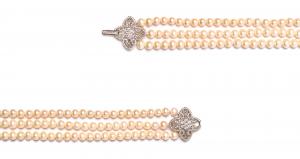
— Ken Bowers
NEW ORLEANS, LOUISIANA, UNITED STATES, June 10, 2024 /EINPresswire.com/ — The evaluation of jewelry is a sophisticated art that combines expert knowledge, keen observation, and a deep understanding of market trends. The Quarter Smith, located in the heart of the French Quarter in New Orleans, has been a trusted authority in jewelry appraisal since its establishment in 1978. Ken Bowers, owner of The Quarter Smith, offers insights into what makes a piece of jewelry truly valuable.
“Jewelry evaluation is about understanding the unique attributes of each piece and how those characteristics align with market demand,” says Ken Bowers.
Key Factors in Jewelry Evaluation
Several factors contribute to the value of a piece of jewelry. These include the quality and rarity of the materials, the craftsmanship, the condition, the provenance, and the current market trends. Each of these elements is meticulously examined during the evaluation process.
Quality and Rarity of Materials
The primary materials used in a piece of jewelry significantly impact its value. Precious metals such as gold, silver, platinum, and palladium are evaluated based on their purity and weight. Gemstones, including diamonds, sapphires, emeralds, and rubies, are assessed for their quality using the four Cs: carat weight, color, clarity, and cut.
Rare and high-quality materials are more valuable. For instance, a diamond with exceptional clarity and color will be worth more than one with visible inclusions or a yellowish tint. Similarly, platinum, being rarer than gold, can add significant value to a piece.
Craftsmanship
The craftsmanship of a piece of jewelry reflects the skill and artistry involved in its creation. Intricate designs, precise settings, and high-quality finishes are indicators of superior craftsmanship. Pieces crafted by renowned jewelry houses or designers often carry higher value due to their recognized expertise and reputation.
Handcrafted jewelry tends to be more valuable than mass-produced items, as it showcases the jeweler’s skill and attention to detail. Unique designs or custom pieces also attract higher valuations due to their exclusivity and artistic merit.
Condition
The condition of a piece of jewelry is a crucial factor in its evaluation. Jewelry in pristine condition, with no signs of wear or damage, is more valuable than pieces with scratches, dents, or loose settings. Regular maintenance and proper storage can help preserve the condition and, consequently, the value of jewelry.
Restoration and repair can sometimes enhance the value of older pieces, especially if done by skilled professionals who can maintain the integrity of the original design. However, extensive repairs or alterations may reduce the value if they detract from the authenticity of the piece.
Provenance
Provenance refers to the history of a piece of jewelry, including its previous ownership and any notable events associated with it. Jewelry with a well-documented provenance, particularly pieces owned by celebrities or historical figures, can fetch higher prices at auction or in private sales.
The provenance adds a layer of narrative and significance to the jewelry, making it more desirable to collectors and enthusiasts. Certificates of authenticity, original packaging, and documented history all contribute to establishing a strong provenance.
Market Trends
The value of jewelry is also influenced by current market trends. Trends in fashion, consumer preferences, and economic factors can affect the demand for certain types of jewelry. For example, vintage and antique pieces may see fluctuations in value based on their popularity in the market.
Understanding these trends requires staying informed about the jewelry market, including auction results, retail prices, and emerging styles. Experienced appraisers like those at The Quarter Smith continuously monitor these trends to provide accurate and relevant evaluations.
The Evaluation Process at The Quarter Smith
At The Quarter Smith, the evaluation process is thorough and detailed, ensuring that each piece is assessed accurately. The process begins with a visual inspection to identify any obvious characteristics or flaws. This is followed by a series of tests and measurements to determine the quality of the materials and the craftsmanship involved.
Each piece is then compared against market data and historical records to establish its value. The final evaluation includes a detailed report outlining the findings and providing an estimated market value. This report can be used for insurance purposes, sale, or personal knowledge.
Conclusion
The art of jewelry evaluation involves a blend of expertise, experience, and an understanding of market dynamics. By considering factors such as the quality and rarity of materials, craftsmanship, condition, provenance, and market trends, appraisers can accurately determine the value of a piece of jewelry.
At The Quarter Smith, the commitment to providing thorough and accurate evaluations ensures that clients receive a clear understanding of their jewelry’s worth. This dedication to excellence has made The Quarter Smith a trusted name in the industry, serving the New Orleans community with integrity and expertise.
Morgan Thomas
Rhino Digital, LLC
+1 504-875-5036
email us here
Visit us on social media:
Facebook
![]()
Originally published at https://www.einpresswire.com/article/718837551/the-art-of-jewelry-evaluation-what-makes-a-piece-valuable




